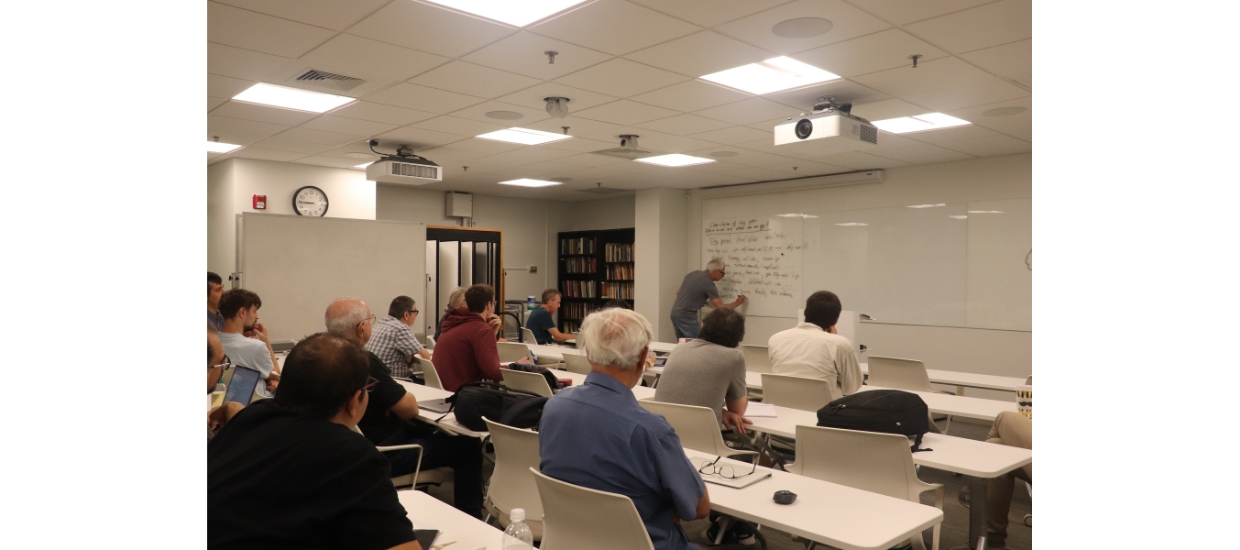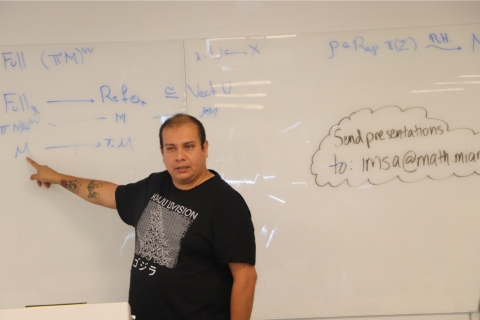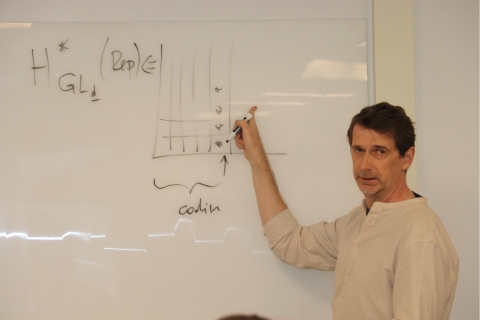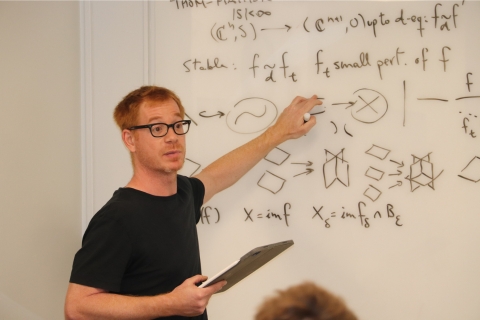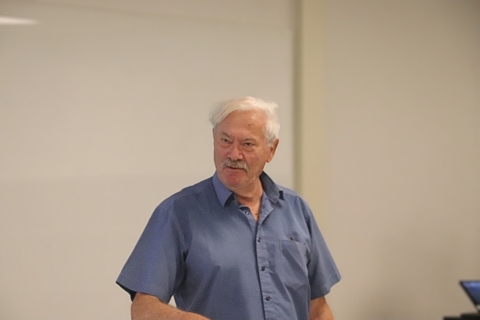Dates: November 4-8, 2024
Location: Ungar Building, Room 528B, University of Miami
Live Video Available via Zoom
Organized by: José Seade
To register, please click here.
Schedule
Monday, November 4, 2024
| 9:00am |
Jean-Paul Brasselet, Institut de Mathématiques de Marseille: Manifolds and singular varieties, yesterday and tomorrow
The aim of the presentation is to assist in the discussions on the future of research based on the founding articles of the theory. Video
|
| 10:00am |
Jörg Schürmann, University of Münster: Characteristic classes of singular spaces. Where we are and where can we go?
We first summarize the development of the theory of characteristic classes of singular spaces up to now. Then we try to give an outlook for possible future applications and research directions. Video
|
| 1:30pm |
Discussion
|
| 4:00pm |
José Seade, Institute of Mathematics, UNAM: Three problems on the subject
I will explain, and give the motivations for, three problems (or lines of research) related to characteristic classes of singular varieties. One is about smoothings of singularities, another on indices of vector fields, and the latter about Milnor classes. Video
|
Tuesday, November 5, 2024
| 9:00am |
José Luis Cisneros-Molina, Institute of Mathematics, UNAM: Secondary characteristics classes for normal surfaces singularities I
Cheeger-Chern-Simons classes are secondary characteristic classes of a vector bundle E over a smooth manifold M with a flat connection. They were defined by Cheeger and Simons using differential characters. In this talk, we show how to use these invariants to study new invariants of normal surface singularities.
i) In the case of a compact oriented 3-manifold L. For topologically trivial representations we will sketch the idea of how to compute the secondary characteristics classes using the Index Theorem for flat bundles by Atiyah, Patodi and Singer. Moreover, if L is a rational homology sphere we will provide a formula for these calculations.
ii) Our construction provides natural elements in algebraic K-theory. We will show this connection. We believe this may give a new perspective of the properties of normal surface singularities.
iii) We have some applications to open problems and to a new interpretation of some invariants. More precisely, we will show the relationship between the secondary characteristics classes and the spectrum to Klenian singularities, and how to use these invariants to complete the classification of maximal Cohen-Macaulay modules over quotient surface singularities. Video
|
| 10:00am |
Agustin Romano, Institute of Mathematics, UNAM: Secondary characteristics classes for normal surfaces singularities II
Cheeger-Chern-Simons classes are secondary characteristic classes of a vector bundle E over a smooth manifold M with a flat connection. They were defined by Cheeger and Simons using differential characters. In this talk, we show how to use these invariants to study new invariants of normal surface singularities.
i) In the case of a compact oriented 3-manifold L. For topologically trivial representations we will sketch the idea of how to compute the secondary characteristics classes using the Index Theorem for flat bundles by Atiyah, Patodi and Singer. Moreover, if L is a rational homology sphere we will provide a formula for these calculations.
ii) Our construction provides natural elements in algebraic K-theory. We will show this connection. We believe this may give a new perspective of the properties of normal surface singularities.
iii) Applications: As a consequence of our work, we have some applications to open problems and to a new interpretation of some invariants. More precisely, we will show the relationship between the secondary characteristic classes and the spectrum to Klenian singularities, and how to use these invariants to complete the classification of maximal Cohen-Macaulay modules over quotient surface singularities. Video
|
| 1:30pm |
Discussion
|
| 4:00pm |
Jakub Koncki, IMPAN: How to compute higher Thom polynomials of multisingularities?
Consider a map of varieties and a singularity germ. We study the locus where the map has the given singularity. Thom polynomial describes the fundamental (or ssm) class of such locus. In the talk, I will focus on methods of computing such polynomials. I will present an improvement in the interpolation method based on stable envelopes ideas. I will show a structure of higher Thom polynomials of multisingularities generalising results of Kazarian.
The talk is based on a joint project with R. Rimanyi. Video
|
Wednesday, November 6, 2024
| 9:00am |
Irma Pallares, KU Leuven: Thom polynomials: An exploratory discussion
Thom polynomials and higher Thom polynomials are polynomials and power series in quotient Chern classes, respectively, with the latter also being closely related to the Chern classes of singular spaces. The aim of this talk is to discuss the possible relationships between the theory of Thom polynomials, other theories of characteristic classes, and their applications. Video
|
| 10:00am |
Laurentiu Maxim, University of Wisconsin-Madison: Linear optimization via Chern-Mather classes
The linear optimization degree gives an algebraic measure of the complexity of optimizing a linear objective function over an algebraic model. Geometrically, it can be interpreted as the degree of a projection map on the affine conormal variety. I will first explain how the geometry of this conormal variety, expressed in terms of its bidegrees, completely determines the Chern-Mather classes of the given affine variety. Moreover, these bidegrees are shown to coincide with the linear optimization degrees of generic affine sections. Relations to polar geometry and the nearest point problem will also be discussed. (Based on joint work with J. Rodriguez, B. Wang and L. Wu.) Video
|
| 1:30pm |
Discussion
|
| 4:00pm |
Matthias Zach, RPTU Kaiserslautern-Landau: Some Le-Greuel type formulas on stratified spaces
The Le-Greuel formula for the Milnor number $\mu(f)$ of an isolated complete intersection singularity (ICIS) $f: (C^n, 0) \to (C^k, 0)$ is widely known and used in singularity theory. In this talk we discuss an extension beyond the classical setup to function germs
$f: (X, 0) \to (C^k, 0)$ on an arbitrary reduced complex analytic space $(X, 0)$ with a Whitney stratification such that $f$ has an isolated singularity in the stratified sense. Since we may not assume anything about the rectified homological depth of $(X, 0)$, this requires a different approach based on Tibar's Handlebody Theorem. We give several topological definitions of counterparts of $\mu(f)$ in this setting which are based on the Nash modification, and we relate them to various ``homological indices'' via local Riemann-Roch-type formulas. In particular, this allows one to compute the numbers in concrete examples using computer algebra. This is work in progress. Video
|
Thursday, November 7, 2024
| 9:00am |
Leonardo Mihalcea, Virginia Tech University: Mather classes for cominuscule Grassmannians
I will explain a recent calculation of Mather classes for cominuscule Grassmannians, and some positivity conjectures. The calculation, done in joint work with R. Singh, utilizes a desingularization of the conormal space of Schubert varieties in these Grassmannians, obtained earlier by Singh. Video
|
| 10:00am |
Paolo Aluffi, Florida State University: CSM classes for matroids
Intersection theory has been extended to the combinatorial setting of matroids, overlapping the geometric setting in the case of hyperplane arrangements. I will review definitions of basic invariants in their combinatorial avatar, and focus on the CSM class of a matroid, defined by Lopez-Rincon-Shaw. A new formula for this class was obtained by applying tools from geometry, leading to a proof of a conjecture of Fife and Rincon on the coefficients of the class for arbitrary matroid. The talk will be based in part on the work of two of my students:
Franquiz Caraballo-Alba and Jeffery Liu. Video
|
| 1:30pm |
Discussion
|
| 4:00pm |
Richard Rimanyi, University of North Carolina at Chapel Hill: On a geometric problem in machine learning (with a singularity theory flavor)
In this talk we will enumerate the main reasons for a collection of matrices multiplying to 0. Our motivation is Bayesian Learning Theory, where one of the goals is to progressively approximate an unknown distribution using data generated from that distribution. A key component in this framework is a function K (relative entropy), which is often highly singular. The invariants of the singularities of K (in the style of `log canonical threshold') are related to how well the Singular Learning Theory "generalizes"---or, in Machine Learning terms, how efficiently the model can be trained (asymptotically). Computing the singularity invariants in real-life scenarios of Machine Learning is notoriously difficult. In this talk, we focus on an elementary example and compute the learning coefficients of Linear Neural Networks. Joint work with S. P. Lehalleur. Video
|
Friday, November 8, 2024
| 9:00am |
Andrzej Weber, University of Warsaw: Characteristic classes with boundary conditions
The process of resolving singularities produces smooth manifolds with smooth normal crossing divisors. The multiplicities naturally associated with the divisors play a key role in the analysis of geometry of algebraic varieties. I will report on the twisted motivic Chern classes which consider boundary multiplicities. I will discuss a connection with elliptic characteristic classes and show application to Schubert varieties and matrix Schubert varieties. It is a joint work with Jakub Koncki. Video
|
| 10:00am |
Guillermo Peñafort, University of Valencia: Cohomological connectivity of perturbations of map-germs
Let f be a holomorphic finite map-germ, defined on a complete intersection. We show that the reduced cohomology of the image of a perturbation of f is concentrated in a range of degrees determined by the dimension of the instability locus of 𝑓. In the non-finite case, we obtain an analogous result, replacing finiteness by K-finiteness and the image of the mapping by the discriminant. This generalizes the previously known estimates for the concentration of the Milnor fibre of complete intersections in terms of the dimension of the singular locus.
|
| 1:30pm |
Discussion
|
| 4:00pm |
Discussion
|
Participants
| Paolo Aluffi |
Florida State University |
Jean-Paul Brasselet |
Institut de Mathématiques de Marseille |
| Jose Luis Cisneros-Molina |
Institute of Mathematics, UNAM |
Leonardo Mihalcea |
Virginia Tech University |
| Laurentiu Maxim |
University of Wisconsin-Madison |
Matthias Zach |
RPTU Kaiserslautern-Landau
|
Irma Pallares
|
KU Leuven |
Guillermo Peñafort |
University of Valencia |
Richard Rimanyi
|
University of North Carolina at Chapel Hill |
Agustin Romano |
Institute of Mathematics, UNAM |
Jörg Schürmann
|
University of Münster |
José Seade |
Institute of Mathematics, UNAM |
Andrzej Weber
|
University of Warsaw |
|
|














